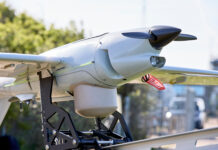ELT Group unveiled two new artificial intelligence (AI)-related initiatives at the Seafutures 2025 event, held in La Spezia, Italy, from 29 September until 2 October.
One project focuses on ‘Virtual & Extended Reality in Maintenance and Training’, while the other centres on ‘Maintenance and Customer Service Management’. Both initiatives involve the integration of AI with augmented-reality and virtual-reality technology.
‘Virtual & Extended Reality for Maintenance and Training’ is an immersive learning project that replicates the real maintenance experience in a digital environment. Technicians can move around these simulated environments, explore equipment, repeat complex operations and learn from their mistakes without risk. Training is thus more effective and infinitely replicable, with an immediate impact on staff autonomy and safety, according to ELT Group.
The project is designed to deliver tangible benefits in terms of both economic savings and operational efficiency. ELT estimates that the learning curve for new hires will be accelerated, with a positive impact on overall productivity. The project also contributes to preserving and enhancing corporate know-how through digital assets, reducing the risks and high costs of skills dispersion.
‘Maintenance & Customer Service Knowledge Management’, meanwhile, is a virtual assistant powered by generative AI, designed to preserve and enhance the technical knowledge of ELT Group, built up over decades of expertise. At the heart of the project is Bright ELT Assistant (BEA): a virtual assistant powered by generative AI (GenAI) capable of communicating in natural language with maintenance technicians and providing quick answers, operational suggestions and references to real cases that have already been resolved. It is essentially a digital work companion, ready to support technicians in real time during an intervention, reducing diagnosis times and increasing the accuracy of activities. The project also allows the skills of senior technicians to be preserved.
“The possibilities generated by these projects are not limited to training alone; they also open up new possibilities for remote maintenance of systems that are often located in operating environments that are difficult and complex for operators,” ELT stated. The company has dedicated a specific area of research and experimentation to this field with the aim of enabling technicians to provide immersive assistance in the field, even thousands of kilometres away, increasing staff safety and efficiency and drastically reducing time and costs. Among the main impacts are a reduction in the average duration of interventions and the average number of technicians per activity: a saving of 10% from the second year of activity, which will grow to 20% from the third year, according to ELT. In addition to these savings, there is further revenue from the sale of the tool as a value-added service, particularly to customers operating in remote areas.
ELT Group has also introduced AI into its products, particularly those that require rapid scenario analysis and real-time reading of large amounts of data to ensure the most appropriate action is chosen in a very short time. ELT stated in its press release that it always guaranteed that a “man is in the loop”, although these scenarios are usually described as having a ‘man over the loop’.
Some examples of AI applications in ELT defence systems include counter-unmanned aircraft system (C-UAS) solutions, simulation and training products, electronic warfare (EW) solutions and the group’s cyber-security products.
In C-UAS systems, AI is integrated into control systems and sensors, automatically monitoring the surrounding environment, detecting suspicious objects and distinguishing between real threats and false alarms with response times and accuracy that are generally much higher than traditional systems based on imperative algorithms. One example is the new Counter-UAS Navale system that ELT Group has designed for the Italian Navy’s new FREMM Evo vessels, a rapid deployment configuration of which is currently installed on a FREMM-class ship currently engaged in operational scenarios.
In integrated simulation and training products that also serve as operational support centres (EW centres) throughout the life cycle of an EW mission, AI provides concrete support for electro-magnetic spectrum operations (EMSO) planning, based on doctrines, tactics and procedures with which the system has been trained.
CY4GATE, a company belonging to the ELT Group and a national and European player in cyber security and cyber intelligence, has built up significant know-how over time in the field of composite AI, ie the ability to exploit the combination of heterogeneous and complementary AI models to solve problems of various kinds. With regard to the field of cyber security, in IT/OT/IoT integration scenarios, behavioural analysis engines, reinforced by AI algorithms, make it possible to intercept significant deviations in order to anticipate threats. The goal is to recognise multi-domain attack chains by reducing detection time, to promptly co-ordinate decision flows and procedures on automated response platforms, suggesting and initiating, where possible, immediate corrective response actions.
“Artificial intelligence is an enabler across all areas of defence. ELT Group has given AI a role as an integrator of other innovative technologies, a multiplier of these capabilities in the operational field and an accelerator of the digitalisation of business processes,” Domitilla Benigni, CEO & COO of ELT Group, was quoted as saying in a company press release. “In particular, the company is using AI to improve processes and product capabilities. The projects developed enable new modes of immersive training with advantages in knowledge transfer and provide the ability to operate remotely in customer support with improved response times and reduced costs. In addition, AI has already been fully integrated by the company into products with enhanced analysis and response capabilities.”







![MGCS status update The KNDS EMBT-ADT 140 technology demonstrator on display at the Eurosatory 2024 exhibition. This model featured the 140 mm configuration of the ASCALON gun. [Mark Cazalet]](https://euro-sd.com/wp-content/uploads/2025/08/EMBT-EDT-140_Mark-Cazalet-Kopie-218x150.jpg)






